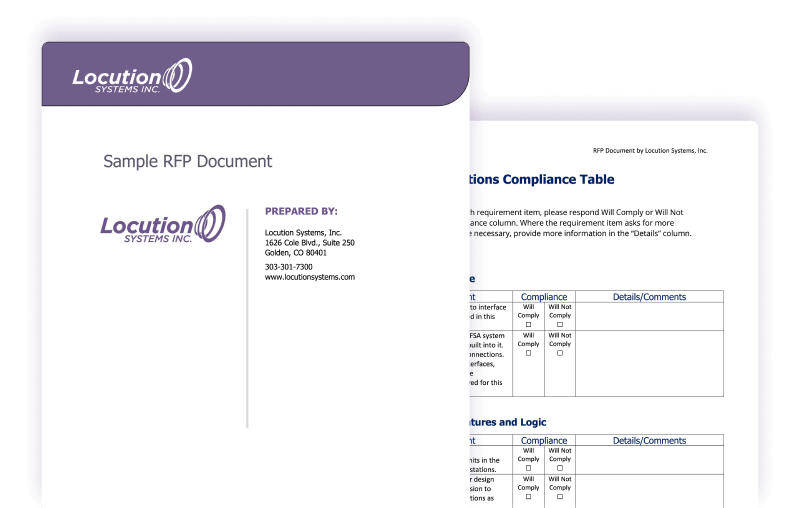Fire Department Grants
Prioritizing Projects with Strict Budgets
Doing more with less has become the unofficial mantra for many departments today. As the expectation of services increases and the need for additional resources rise to meet the new demand, fire departments are met with reduced budgets and tightened fiscal constraints. Prioritizing projects with strict budgets has become an invaluable skill for key decision-makers within departments.
Although some have found ways to maintain their services on a tighter budget, others have struggled to build on their foundations to improve their services.
Yet, when a department does have discretionary income to allocate to an improvement project the question becomes: “how do we best allocate these funds to provide the greatest benefit to the department and community?”
We sat down with Chris Mailes, Fire Chief for the Santa Barbara Fire Department, to find out how he approaches this challenge and continues to grow the capabilities of his department.
Question 1: What is the biggest challenge when deciding where to allocate funds for department projects?
Chris’ response: “At the forefront of every fire department manager’s decision-making plan is the underlying theme of the mission statement of the fire department. The mission statement serves as the core principles and guidelines for making all decisions.
Additionally, our fire department makes decisions based on the following questions:
- Is it good for the community?
- Is it good for the department?
- Is it good for the Battalion?
- Is it good for the individual personnel?
If a decision addresses and answers all the questions in the affirmative, it passes an initial test to deserve our attention. Of course, the most important question is ALWAYS the community.
We are indeed challenged with doing more with less. The easy answer for us would be to simply do less with less. However, turning off the lights is not an option. The public relies on us to have an effective response force for any emergency that arises within our community. In the City of Santa Barbara, our fire department has the following significant target hazards: interstate, railroad, airport, harbor, and wildland-urban interface. Anyone that has heard of Santa Barbara thinks “fires and floods”, as we have had some of the most media-intensive incidents in recent history.
Property values in the city put additional pressure on the department. Single-family residences in the city are typically well over one million dollars. A “room and contents” fire can easily reach the quarter to half a million-dollar loss. Not to diminish the cost of anyone’s home but, fire loss is exponentially increased in high-value communities.
Doing less is certainly not an option. We must “push stuff down” to department members and the involvement of all personnel is imperative. Doing more with less requires that all managers, as well as rank-and-file personnel, be fully engaged as active participants. It encourages collaboration.
One of the biggest roadblocks for fire departments is that typically 80%-90% of a department’s budget is allocated to personnel costs. This is typical of all paid municipal fire departments. This leaves only 10%-20% as “discretionary” funds. Discretionary funds include but are not limited to: facilities, apparatus, communications infrastructure, equipment, and supplies. These discretionary funds are continually evaluated for cost and efficiency. However, if the large majority of an agency’s budget is off-limits or “untouchable,” fire managers are tasked with being very efficient with the dwindling dollar.
The allocation of “excess” or discretionary funds depends largely on the price tag of the item. In city government, large funding must be evaluated and approved by council members and/or city managers. This funding approval is often evaluated by multiple department personnel along with the Fire Chief. As an example, the purchase of a fire engine is usually approved after the Fire Chief makes the recommendation. Additionally, many department members often have a “hand” in building out an engine. Committees often prepare a “spec” that is cost-effective and meets the needs of the community we serve. Funding for that engine is often based on amortization schedules that follow NFPA recommendations.”
Question 2: How do you maintain your motivation to continue to improve the department given the uphill battle to do so?
Chris’ response: “Working as a firefighter is an honor that no one should take for granted. It is truly a privilege to serve our city. I always tell new firefighters that I don’t know of another job where someone will gladly open their door at 3 am to ask for help. When someone is vulnerable, traumatized and in need of help, we are honored to serve.
I tell people that my 87-year old mother lives in our community. Every call is someone’s mother, father, son, or daughter. Treat them like you would want your own family treated. If that is always in the back of your mind, you will provide wonderful care.
Sure, we can get bogged down in the uphill battle, however, if you keep your focus on the community and realize that all decisions you make can literally be life or death, it keeps you motivated to continue to strive for greatness.
Our department does a great job of involving our firefighters with projects. It seems we have a committee for everything. This leads to an empowered workforce who becomes motivated based on their need to be included. We have a very strong management workforce team. One of the best examples of this was the Locution FSA project. When I started this project, I couldn’t spell “Locution.” I immediately grabbed a few core personnel who were specifically interested in communications. Our initial meeting with Locution FSA was very enlightening. I was particularly impressed with Glenn Neal’s obvious respect for his employees. He seemed very humble and deferred to his employees for valued input and guidance. Every one of the employees seemed happy too! Their enthusiasm was palpable. This translated to an enthusiastic group of firefighters!
Our management team members are not micro-managers. We simply can’t be. We have a very small management team and we must stay at a high level to accomplish the needed staff responsibilities. With a small management team, we don’t have time to wander around in the weeds. This is why soliciting floor personnel and the formation of committees is a win-win for us. The Locution project involved over 30 city employees with at least 20 fire personnel involved from start to finish.”
Question 3: What is your assessment process like when having to choose between multiple ways to use limited resources?
Chris’ response: “See above. Who does it benefit? An individual or an entire community? Is it something essential to our mission or just a “nice to have?” We operate on a two-year budget cycle. Capital expenditures are usually forecasted and set. We have very little discretionary spending. While this limits us in the short-term, it requires us to plan accordingly with multiple “asks” at budget time. The management team must thoroughly plan and prioritize capital purchase requests.
If we are not able to obtain desired large purchases, we solicit requests via grants, local foundations, and philanthropic donations. We are fortunate to have two non-profit public safety foundations that supply much-needed equipment to local line personnel (Santa Barbara Firefighters Alliance and One805 Foundation).
Additionally, departments are looking for revenue streams. Our county fire departments may be bidding on the ambulance contract as a means of securing the financial future of our county. Revenue would be reinvested into the EMS system creating opportunities not seen before. This is a long-term project that has been in the works for several years.
With the COVID-19 pandemic, our city has seen a tremendous decrease in revenue. Our revenue comes primarily from three areas: transient occupancy tax (bed tax), sales tax, and property tax. Two of our main revenue sources have seen significant decreases with only property tax holding steady. The future is very uncertain which puts an added emphasis on being fiscally conservative.”
Question 4: What is the hardest part of getting approval for a new project and how do you overcome it?
Chris’ response: “The hardest part is being able to plan and forecast needs up to two years in advance. Projects are thoroughly vetted at multiple levels of city government. We don’t approve “pet projects” and allocated money is thoroughly evaluated. Capital purchases are not decided overnight. We must have a clear vision for the future and know exactly where we want to be in two years. Short, medium, and long-term planning and goals are paramount.”
Question 5: How are strict budgets influencing how fire departments are making decisions?
Chris’ response: “This is a problem nationwide. Departments are already making substantial cuts including employee pay and benefit concessions, deferral of maintenance and replacement, browning or blacking out fire stations, etc. These are extraordinarily tough times, but this is when fire managers need to shine. Uncertainty brings on anxiety. It is imperative that fire managers create a sense of calm out of the chaos. We must be able to articulate the history of budget shortfalls. The stock market crash of 2008 is a distant memory for some, but we must draw on the experience of what we learned as this pandemic could cause multiple years of impacts to the fire service.”
Question 6: What about an FSA system made you prioritize that project above others?
Chris’ response: “Our city had a very antiquated station alerting system. Known as the “quick call” or “two-tone sequential encode system”, the system had been in place since the 1960s. Simply put, we were due for a major upgrade. Departments are always striving to meet NFPA response time guidelines. Some parts of the overall response time cannot be changed. One static factor is travel time. Short of moving fire stations or deploying firefighters on street corners, travel time is something that shows no statistical deviation. Call processing time and turnout time are highly dynamic time factors, they can be shortened with work. All information to shorten call processing and turnout time pointed to an automated alerting system. I researched the alerting options and submitted a request to the city for the capital expenditure. It was initially denied, however, the request was kept in a file. Shortly after, our city researched and got passed a one-cent sales tax. It was estimated to bring in twenty-two million dollars in revenue specifically for public safety and infrastructure. There was no sunset clause placed into the ballot measure. Measure C was passed by our voters. A Measure C steering committee debuted the FSA system as the first project of this voter-approved sales tax.”
Question 7: You have leveraged voter-approved dollars to help fund your FSA project, do you have advice for others seeking additional sources of funding for department improvements?
Chris’ response: “This largely depends on a department’s community support and whether the climate supports elevating a department above the status quo. Sometimes departments “don’t know what they don’t know.” I was surprised in my initial education of an FSA system, how many key players in communications did not know about an IP-based automated alerting system. The data was there to show savings in response time, employee fatigue, burnout as well as efficiency of the dollar. The education I provided to key policymakers was invaluable and provided an immediate positive response. Typically met with a “wow,” the FSA system really became an easy sell when it was presented with such overwhelming benefits.”
Question 8: What was your strategy to prove the value of the investment to stakeholders in the project?
Chris’ response: “One second of response time is valued at $58,000. This one second was not an anecdotal guess, it is based on several time factor studies for various types of emergencies. However, due to the complexity of this analysis, I chose to emphasize the decrease in overall response time based on decreased time-to-dispatch and turnout times. We estimated a very conservative 30 seconds of response time based on the decrease of the call processing and turnout times.
When looking at the concept of “doing more with less” we were also able to articulate the intense workload of our communications dispatchers. Our city has a combined communications center (Police and Fire) and we also are a full Emergency Medical Dispatch (EMD) call center. Like most departments in California, we are seeing a significant rise in call volume. Most of California is seeing a 7% annual rise in EMS calls and a 4% rise in overall call volume. Our dispatchers are spending more time with callers on 911 calls, often at the expense of delayed dispatching of units. The FSA system allowed for much easier multi-tasking and the ability to get a call out to a fire apparatus much faster. Pressure from our county EMS Agency to “not interrupt EMD,” was a huge selling point for an FSA system. Now our dispatchers have completely changed their focus from the radio to the reporting party and the 911 call. We have seen some calls dispatched in under 10 seconds.”
Question 9: Who or what were invaluable resources to help you navigate these decisions that others would benefit from?
Chris’ response: “The big point I would make is to drop one’s ego and rely on collaboration. A group can accomplish so much more than an individual. For an FSA system, a committee is imperative. The make-up of the committee should include an internal project manager, dispatch staff, IT personnel, station representatives, and the most qualified home improvement/contractor in your department. Additionally, it’s important to instill passion in any funding steering committee and of course the government purchasing department.”
Question 10: Looking towards the future, what skills are going to be critical for departments to adapt to the tighter operating margins?
Chris’ response: “A fire department is a business. Whether it’s a completely volunteer company or a large municipal department, all must be prudent fiscal stewards. The leaders of the department must be formally educated and have good business sense. The ability to navigate the budget process, look for other ways to do business, and most importantly to identify funding sources cannot be overstated.”
Like what you see? Share with a friend.
Related Posts
Subscribe Now
Stay Connected with the First Responder Resource Center
Sign up for the First Responder Resource Center from Locution Systems and gain access to valuable insights, industry updates, and expert resources designed to support first responders. Simply enter your information on the right, and you’ll receive exclusive content, news, and updates straight to your inbox. Stay informed and connected—join today!



